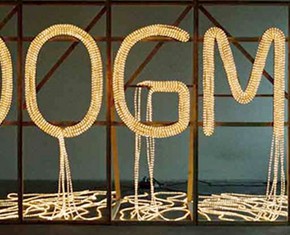The views expressed in our content reflect individual perspectives and do not represent the authoritative views of the Baha'i Faith.
He saith: “His eyes were as a flame of fire”, and “brass-like were His feet”, and “out of His mouth goeth a two-edged sword”. [See Revelations 1:14–16; 2:18; 19:12, 15.] How could these words be literally interpreted? Were anyone to appear with all these signs, he would assuredly not be human. And how could any soul seek his company? Nay, should he appear in one city, even the inhabitants of the next would flee from him, nor would any soul dare approach him! Yet, shouldst thou reflect upon these statements, thou wouldst find them to be of such surpassing eloquence and clarity as to mark the loftiest heights of utterance and the epitome of wisdom. Methinks it is from them that the suns of eloquence have appeared and the stars of clarity have dawned forth and shone resplendent. – Baha’u’llah, Gems of Divine Mysteries, pp. 52–53.
Whenever anyone encounters a passage of scripture, it requires a decision—is the passage literal or symbolical, metaphorical and figurative? That initial determination makes all the difference.
This essay presents a series of steps, what scholars would call a hermeneutical approach or technique, for figuring out prophecy:
1. If impossible, then not literal.
2. If not literal, then figurative.
3. If figurative, then symbolic.
4. If symbolic, then spiritual and social.
These methods don’t exhaust every prophetic possibility, but rather provide a useful interpretive tool. Let’s try a prime example of the spiritual understanding of prophecy, by taking a look at Peter’s sermon at Pentecost from Acts 2:14–21:
But Peter, standing up with the eleven, raised his voice and said to them, “Men of Judea and all who dwell in Jerusalem, let this be known to you, and heed my words. For these are not drunk, as you suppose, since it is only the third hour of the day. But this is what was spoken by the prophet Joel:
And it shall come to pass in the last days, says God,
That I will pour out of My Spirit on all flesh;
Your sons and your daughters shall prophesy,
Your young men shall see visions,
Your old men shall dream dreams.
And on My menservants and on My maidservants
I will pour out My Spirit in those days;
And they shall prophesy.
I will show wonders in heaven above
And signs in the earth beneath:
Blood and fire and vapor of smoke.
The sun shall be turned into darkness,
And the moon into blood,
Before the coming of the great and awesome day of the Lord.
And it shall come to pass
That whoever calls on the name of the Lord
Shall be saved.’
 Here, Peter quotes Joel 2:28–32, not as a prophecy to be fulfilled in the future—but as one fulfilled in the present on the Day of Pentecost, the event which represents the birth of the Christian church.
Here, Peter quotes Joel 2:28–32, not as a prophecy to be fulfilled in the future—but as one fulfilled in the present on the Day of Pentecost, the event which represents the birth of the Christian church.
No contemporary history has attested to the physical occurrence of these celestial events—i.e. that the sun turned dark and the moon became crimson, which events evidently did not occur, even though Peter said they did. This fact alone compels the conclusion that Peter understood Joel’s prophecy as a spiritual event, not as a literal one.
Now let’s take a look at the prophecy that Baha’u’llah comments on above: Revelations 1:14–16; 2:18; 19:12, 15. As for Step 1, Baha’u’llah rules out a literal interpretation with this compelling reasoning:
How could these words be literally interpreted? Were anyone to appear with all these signs, he would assuredly not be human. And how could any soul seek his company? Nay, should he appear in one city, even the inhabitants of the next would flee from him, nor would any soul dare approach him! – Gems of Divine Mysteries, p. 52.
Step 2 asks us to determine the nature of the figure of speech itself. Baha’u’llah describes “His eyes were as a flame of fire” this way:
Know then that He who uttered these words in the realms of glory meant to describe the attributes of the One Who is to come in such veiled and enigmatic terms as to elude the understanding of the people of error. – Gems of Divine Mysteries, p. 53.
These “veiled and enigmatic terms” are obviously figurative, not literal. Furthermore, this figure of speech is a simile. Simple as that!
For Step 3, when we try to identify the qualities conveyed by the figurative language, we could simply ask: “What qualities could ‘flames of fire’ represent?” Here, Baha’u’llah does just that:
Now, when He saith: “His eyes were as a flame of fire,” He alludeth but to the keenness of sight and acuteness of vision of the Promised One, Who with His eyes burneth away every veil and covering, maketh known the eternal mysteries in the contingent world, and distinguisheth the faces that are obscured with the dust of hell from those that shine with the light of paradise.
Were His eyes not made of the blazing fire of God, how could He consume every veil and burn away all that the people possess? How could He behold the signs of God in the Kingdom of His names and in the world of creation? How could He see all things with the all-perceiving eye of God? …For, indeed, what fire is fiercer than this flame that shineth in the Sinai of His eyes, whereby He consumeth all that hath veiled the peoples of the world? – Gems of Divine Mysteries, p. 54.
As for Step 4, when we try to determine the spiritual event the prophecy alludes to, Baha’u’llah hints of, but does not openly disclose, the spiritual event—the advent of Baha’u’llah himself, in fulfillment of these very prophecies of the Book of Revelation.
In fact, we know that this prophecy cannot literally refer to Jesus Christ, at least in name, for Revelations 19:12 reads, in full:
His eyes were as a flame of fire, and on his head were many crowns; and he had a name written, that no man knew, but he himself.
This is the “new name” previously referred to in Revelations 2:17 and 3:12:
To him that overcometh will I give… a white stone, and in the stone a new name written, which no man knoweth saving he that receiveth it.
I will write upon him the name of my God, and the name of the city of my God, which is new Jerusalem, which cometh down out of heaven from my God: and I will write upon him my new name.
If, like most of us, you’ve ever struggled to understand the mysteries of prophecy, this technique can help. In tomorrow’s essay, we’ll review some basics about figurative language that can help even more.
















Comments
Sign in or create an account
Continue with Googleor